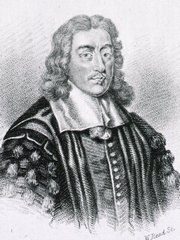This article is part of the series "A Moment in History" where we honor those who have contributed to the growth of medical knowledge in the areas of anatomy, medicine, surgery, and medical research.

Thomas Willis
UPDATED: Thomas Willis (1621-1675). An English physician and anatomist, Willis was born on his parents' farm in Great Bedwyn, Wiltshire, where his father held the stewardship of the Manor. He was a kinsman of the Willys baronets of Fen Ditton, Cambridgeshire. He graduated M.A. from Christ Church, Oxford in 1642. In the Civil War years he was a royalist, and was dispossessed of the family farm at North Hinksey by Parliamentary forces. In the 1640's Willis was one of the royal physicians to Charles I of England. He obtained his medical degree in 1646.
Thomas Willis might well be one of the greatest physicians of the 17th century.He is one of the founders of the Royal Society of London. He is remembered by his many publications, especially "Cerebri Anatome: Cui accessit Nervorum Descriptio et Usu", where he describes the arterial anastomoses at the base of the brain. This work is also the first detailed description of the vasculature of the brain. Willis described nine cranial nerves.
He is considered as the father of Neurology as a discipline. He used the term "neurology" for the first time in 1664. He described several neurological conditions
The Arterial Circle of Willis is a famous eponymous structure found at the base of the brain. It represents an anastomotic roundabout that connects the right and left sides as well as the carotid and vertebral arterial territories that supply the brain. Named after Thomas Willis, this structure was known well before him, but it was Willis who described its function. You will be redirected to a detailed description of this structure if you click here.
Sources:
1. "The legendary contributions of Thomas Willis (1621-1675): the arterial circle and beyond" Rengachary SS et al J Neurosurg. 2008 Oct;109(4):765-75
2. "Thomas Willis, a pioneer in translational research in anatomy (on the 350th anniversary of Cerebri anatome)" Arraez-AybarJournal of Anatomy, 03/2015, Volume 226, Issue 3
3. " The naming of the cranial nerves: A historical review" Davis, M Clinical Anatomy, 01/2014, Volume 27, Issue 1
4. "Observations on the history of the circle of Willis". Meyer A, Hieros, R.Med Hist 6:119–130, 1962
Original image in the public domain courtesy of the National Library of Medicine.



